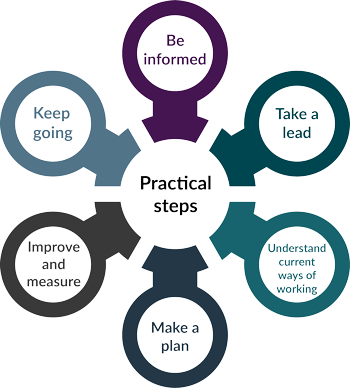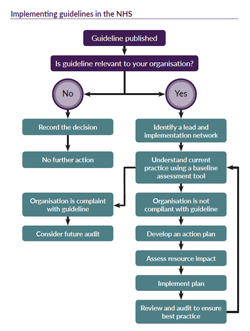Practical steps to improving the quality of care and services using NICE guidance
This practical guide shows how you can use evidence to improve care and services. It is for anyone with an interest in improving practice.
It sets out the most common steps taken when putting evidence-based guidance into practice. The steps are drawn from published literature as well as our work with:
- NHS organisations
- local authorities
- social care providers
- voluntary organisations.

Principles for putting evidence-based guidance into practice
This guide covers the main conditions needed to ensure a positive environment for change and help everyone deliver high-quality care and services.
It covers the following key principles:
- commitment to quality improvement
- effective leadership
- the right culture
- working together.
How NICE guidance and standards can help you
Understand how our guidance and standards can help you if you're:
- a policy maker
- a provider or practitioner
- an advocate for patients or people being supported by social care services
- a commissioner
- using health or social care services or you are a carer
- working in system transformation.

About our resources
Professor Robbie Foy on behalf of the NICE Implementation Strategy Group.
Research continually produces new evidence that can improve care and lives. However, this evidence does not always find its way into routine practice. NICE guidance and quality standards play a key role in reducing gaps between recommended and actual practice, but successful implementation depends on national and local action. These resources highlight practical steps to support such action.
Just as NICE promotes evidence-based practice, these resources promote evidence-based implementation. They draw on scientific evidence that has evaluated many different approaches in a wide range of settings and sectors. For example, well over 140 randomised trials show that giving professionals feedback on their performance improves care.
Rigorous research studies also suggest that most actions to put guidance into practice have relatively modest effects. But even small service-level changes can have substantial effects on the population and offer good value for money. Adopting the practical steps as ‘organisational habits’ will provide a solid foundation for achieving long-lasting impact.
Implementation flowcharts

Our flowcharts show you how to implement each type of NICE guidance. These can be used as a starting point for developing local processes.
Implementing guidelines in the NHS (PDF)
Implementing technology appraisal guidance in the NHS (PDF)
Implementing interventional procedures guidance in the NHS (PDF)
Implementing diagnostics and medical technologies guidance in the NHS (PDF)
How to change practice: understand, identify and overcome barriers to change
This guide provides practical advice on how to encourage health and social care professionals and managers to understand, identify and overcome barriers to change. This will enable them to change practice in line with the latest guidance.
- Part 1 discusses the types of barriers to change encountered in healthcare.
- Part 2 offers practical suggestions for how to identify the barriers to change in your organisation.
- Part 3 shows how to overcome these barriers, and highlights potential levers to help people do this. Real life examples are provided illustrating how the methods described have brought about positive changes in a range of situations.
The first stage in the development of the guide was to commission the Kings Fund to carry out a literature review in the area of changing behaviour and provide an overview of the evidence. This aimed to identify the types of barriers that exist and the interventions that encourage clinicians to change.
We held a workshop with users to support the development of the guide and to gain support for the overall direction of our work. The workshop explored the barriers that exist, interventions identified from the literature and basic drivers for change at an individual, local, and national level. We then carried out a targeted consultation on the draft guide over a 4 week period. The consultation comments received were extremely valuable and where appropriate, were incorporated into the guide.
A list of organisations and individuals who contributed to the development of this guide is available below.
